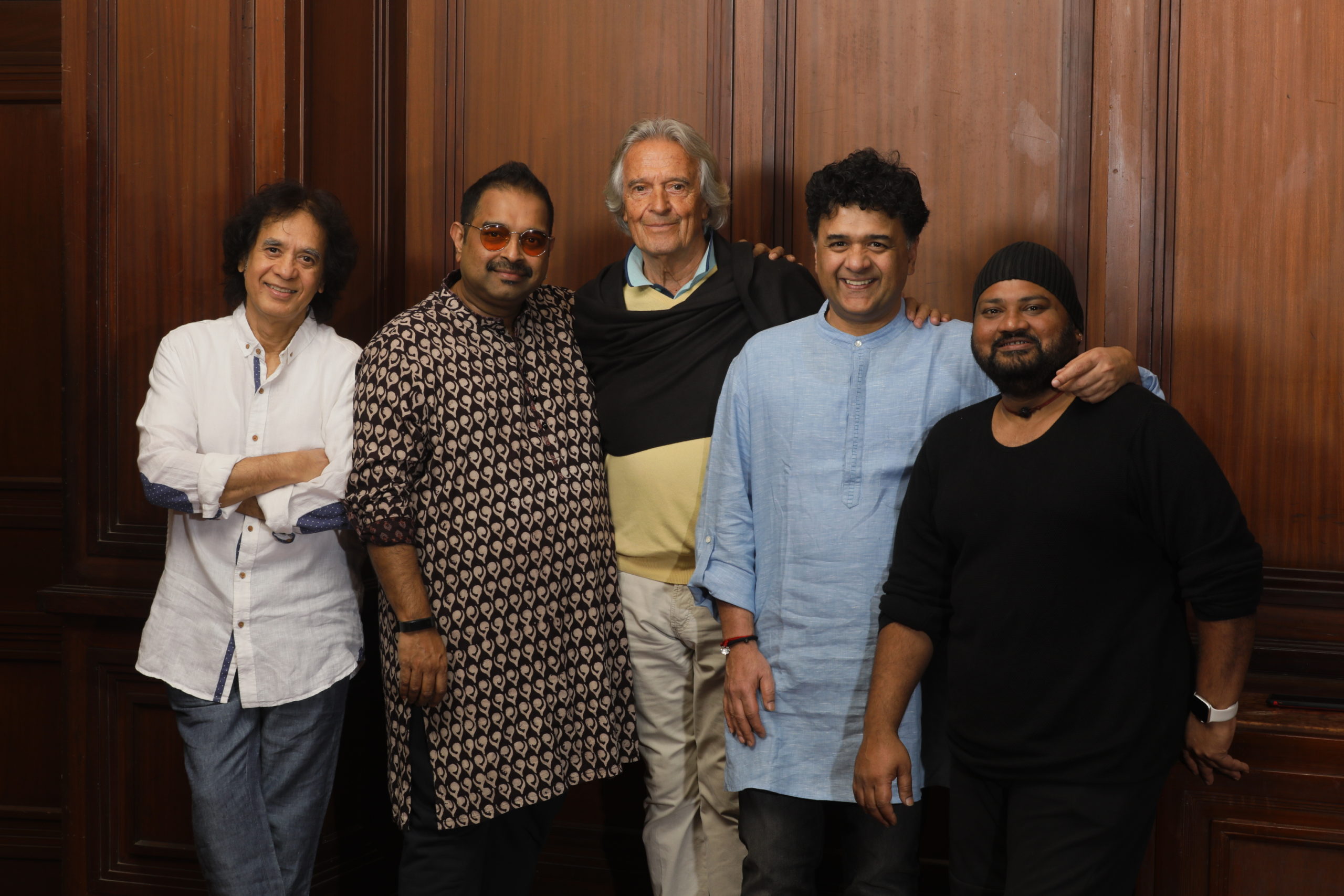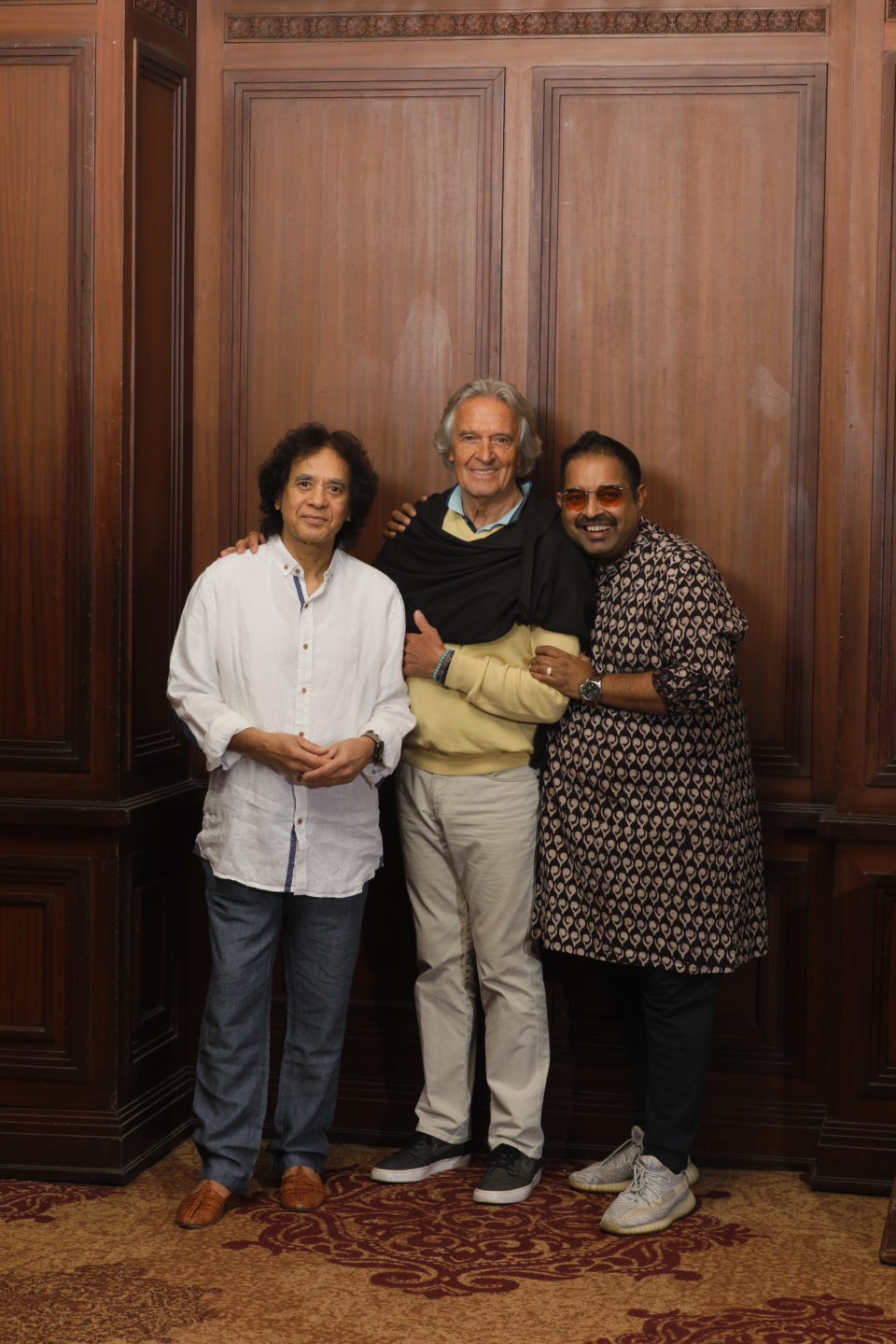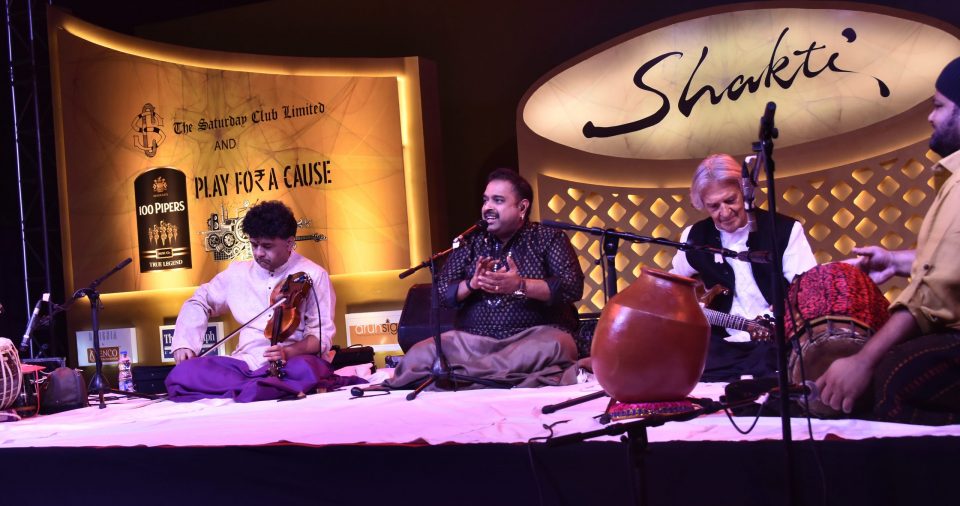
COVER STORY: Celebrating 50 Years of Shakti
As the latest avatar of the legendary Indo-jazz fusion band kicks off its 50th anniversary Indian tour this month, we spoke to John McLaughlin and Zakir Hussain about their five decade-long journey
When British guitarist John McLaughlin first met young tabla player Zakir Hussain in New York in 1969, he felt a connection, but never imagined that they would be musically associated for five decades. “I felt an immediate affinity with him, and we stayed in touch even though he lived on the West Coast and I on the East Coast,” he recalls.
The two musicians first played together at sarod maestro Ustad Ali Akbar Khan’s residence in California in 1972. Zakir was 21 years old, a child prodigy who had been touring with his father, the legendary Ustad Alla Rakha, since he was twelve. His rising fame meant that he was already friends with the likes of George Harrison and Mickey Hart. McLaughlin was 30, and was by then considered one of the great electric guitarists of the era.
Born in Doncaster, England, he had given guitar lessons to Jimmy Page, played in a band with Ginger Baker and moved to America in 1969, where his talent was appreciated very early. He had jammed with Jimi Hendrix at his Electric Lady studios, and had played on six Miles Davis albums. Davis had even named a song — “Go Ahead John” — on the album Big Fun after him. McLaughlin was also famous for setting up The Mahavishnu Orchestra, iconic Indian music influenced jazz fusion band that he set up in 1971 with drummer Billy Cobham, keyboardist Jan Hammer, violinist Jerry Goodman and bassist Rick Laird.
McLaughlin was already a fan of both Indian philosophy and classical music and had become a disciple of the spiritual leader Sri Chinmoy along with the likes of Carlos Santana and Roberta Flack. He saw a lot of common ground between jazz and Indian music, and was learning to play the veena from virtuoso S. Ramanathan. One thing led to another, and the guitarist met mridangam player Ramnad Raghavan, who introduced him to the then upcoming violinist L. Shankar and ghatam exponent Vikku Vinayakram. Zakir joined them and thus was born the idea of Shakti, the pioneering Indo-jazz fusion band, whose sound would blend jazz with Hindustani and Carnatic classical music.
Many of these anecdotes come to McLaughlin’s mind on the eve of Shakti’s forthcoming 50th anniversary India tour, starting this month. Of course, there have been changes in the band’s lineup over the years as well as its name over the years. Shakti made way for Remember Shakti while reverting back to the original name now, McLaughlin and Zakir being the only original band members who still remain. The current lineup includes vocalist Shankar Mahadevan, violinist Ganesh Rajagopalan and kanjira player V. Selvaganesh. The tour will take the band to Bengaluru on January 20th, Mumbai on January 22nd (where Vikku Vinayakram will join the band on stage as special guest) Kolkata on January 24th and New Delhi on January 28th.
The musicians are excited. Says Zakir, “The family is getting together again. I am ready for the love that will be there aplenty.” Adds McLaughlin, “I don’t know how many older tunes we shall play, but the shows will represent a musical history dated back 50 years to the Shakti music of today.”

Naturally, fans have made sure their tickets are in place. A sizeable section remembers first seeing the band when guitarist Larry Coryell came in 1982 in place of McLaughlin, who had injured his hand. When McLaughlin came in 1984, the shows were a phenomenal success, and for many old-time fans, that was the best Shakti phase. Other fans recall the Remember Shakti shows in the early 2000s, when Shankar Mahadevan, Selvaganesh and mandolin wizard U. Srinivas were part of the lineup, or the Kolkata concert in 2020, when Ganesh Rajagopalan joined. Still others remember the brief phase in 1997, when flautist Hariprasad Chaurasia was part of the group.
It’s been a long evolution, and though the broader concept has been the same, there have been different elements over the years. What makes Shakti so special? To analyze that, one has to go into related forms of music that have existed from the late 1960s. Here, two genres come to mind – jazz fusion and east-west collaborations.
In the late Sixties, with rock music taking over youth tastes, jazz musicians thought of means to fuse jazz with rock. By the turn of the decade, trumpeter Miles Davis, guitarist Coryell, McLaughlin’s Mahavishnu Orchestra and the group Weather Report were among those active in that space. Soon, it became fashionable to blend music from different parts of the world. The fusion of jazz with Brazilian bossa nova had been hugely successful, after all.
Simultaneously, Indian music was becoming popular in the West, thanks mainly to sitar maestro Pandit Ravi Shankar, sarod great Ustad Ali Akbar Khan and tabla maestro Ustad Alla Rakha. In 1967, Ravi Shankar and western classical violinist Yehudi Menuhin released the album West Meets East. Sitar players Harihar Rao and Ananda Shankar, and westerners John Mayer and Joe Harriott, also played music blending Indian and western music. Jazz musicians John Coltrane, John Handy, Don Cherry and Colin Walcott were influenced by Indian sounds.
Besides music, musicians from the West were also influenced by Indian spiritualism and yoga. Menuhin practised yoga regularly, and the Beatles visited the ashram of Maharishi Mahesh Yogi in Rishikesh in 1968, with George Harrison also becoming a close friend of Ravi Shankar.
Soon, McLaughlin and Carlos Santana became disciples of spiritual guru Sri Chinmoy, who named them Mahavishnu and Devadip, respectively. That’s how McLaughlin named his band the Mahavishnu Orchestra, though its sound was more jazz-rock than India-inspired music. Besides spiritual leaders and mystics like Ramana Maharishi, Swami Vivekananda, Ramakrishna Paramahansa and Nisargadatta, he also got exposed to Carnatic veena maestro S. Balachander and that’s how his passion for Indian music began. Since he also heard Ravi Shankar and Ali Akbar Khan extensively, the broad idea of blending jazz with both north and south Indian music was formed.
At that time, Zakir and L. Shankar were regularly doing rounds of the U.S., playing Indian classical music. When they met McLaughlin, the chemistry was just right. By 1973, they had begun to play together, and by 1976 they gained global recognition as the game-changers of Indo-jazz fusion. Raghavan did only two shows with them.
Though one could sense the strong dose of Indian music in their mix, Shakti had a very distinct acoustic sound. An 18-minute track called “Joy,” recorded at Southampton College in New York’s Long Island, became a rage. The tunes “La Danse du Bonheur,” “India,” “Isis,” “Two Sisters,” “Mind Ecology,” “Face To Face” and “Bridge Of Sighs” became fan favorites, and “Lotus Feet” was an improvisation of the tune played by the Mahavishnu Orchestra. Carlos Santana described Shakti as the most intense music he had ever heard.
How did the Mahavishnu fans react? Says McLaughlin, “They reacted favorably for the most part. It was the record company and my agent who were annoyed that I was abandoning a highly successful group in order to play with Shakti. I told them I will assume the consequences and they will have to do the same. However, 50 years later it is Shakti that is here and not the Mahavishnu Orchestra.”
The group toured heavily, and also released three albums – Shakti With John McLaughlin, A Handful Of Beauty and Natural Elements. All the three records, on the CBS label, did exceedingly well. Though the band members got busy with individual projects, they came together in the early Eighties for a series of tours.
The India tours, specially the one featuring McLaughlin in 1984, spawned a new set of fans. Dallas-based Rajiv Pandey recalls watching them at Kolkata’s ITF Pavilion on March 20th, 1984. “I was about 16-17, and this was one of my first live shows. The band tore my head clean off. Shankar played a Ken Parker double bow violin and that brought a sound that really made a massive difference.” Another fan, advertising professional Arijit Sengupta, remembers seeing them in New Delhi on that tour. “Every minute was fabulous, but if one song created the maximum impact, it was ‘Bridge Of Sighs.’ That memory still remains,” he says.
Zakir has very fond memories of the early days. He recalls, “John bhai and Shankar would work on the main compositions, but they would allow me and Vikku ji to come up with the rhythm element to support the compositions. Many of the korvais (tihais) and rhythm transitions were thought of by Vikku ji and me, and generously included into the songs by them.”
The tabla maestro also faced the challenge of balancing his Shakti work with Indian classical performances. He says, “Shakti would tour at certain times of the year. That made it a bit easier for me to balance my teaching assignment at the Ali Akbar College in San Francisco. I was also playing concerts with Khan saheb and he was concerned as was my father (Ustad Alla Rakha) and Ravi Shankar ji that I would neglect my classical performances. But I was very focused on keeping my Indian classical life in the forefront. It was also helpful that Shakti did not tour India when it was first formed.”
However, a turning point also came when Vinayakram’s father passed away. According to McLaughlin, it necessitated that he would leave the group and return to Chennai to take care of the percussion school his father had founded.
The musicians continued to work together in different combinations. Shankar and Zakir collaborated with drummer Trilok Gurtu on the 1985 album Song For Everyone. Two years later, Zakir and McLaughlin were joined by Chaurasia on the album Making Music. Both these albums featured Norwegian saxophonist Jan Garbarek.
In 1997, the Remember Shakti tour of Europe and India would include Chaurasia, along with McLaughlin, Zakir and Vinayakram. According to McLaughlin, the flautist wasn’t the first choice for the reunion. “Both Zakir bhai and I tried for weeks on end to contact L. Shankar but it was impossible to get a reply to our calls, faxes etc. Having performed with Hari ji (Chaurasia) we invited him. He made the tour with us, but he such a great and sought-after artist it became imperative that we find another musician to replace him.”
‘Mandolin’ Srinivas became the choice after McLaughlin saw a video of Vinayakram and him at the Berlin Jazz Festival. “He agreed immediately and the rest is history,” says the guitarist. Simultaneously, Selvaganesh joined on kanjira. Asked about the fact that Shakti always had two percussionists, Zakir says, “It was advantageous that the others are all from the Carnatic tradition. At least in that I did not have to radically alter my thinking process. From Vikku ji I learnt an immense amount of taal vidya. There was no divide, no fences. From the very first day, it felt right. Selva bhai has grown on Shakti music and is an extension of Vikku ji. No problem at all.”
McLaughlin says that by 1999, he felt that Shakti was ready for a singer. He specifies, “But this would not be any singer. Zakir bhai and I discussed this at length and in fact I was dreaming of finding someone like [Carnatic vocalist] K.V. Narayanaswamy. The next time Zakir bhai went to India, he met with Shankar Mahadevan and recommended him to me. A week later I received a CD sent to me by Shankar ji himself. One minute of listening and I was on the phone to him. Shankar ji is one of those rare musicians who can sing anything. To top it all off, he is a master of improvisation.”
The lineup of McLaughlin, Srinivas, Mahadevan, Zakir and Selvaganesh recorded the famous Remember Shakti album Saturday Night In Bombay at Mumbai’s Rang Bhavan in 2000, with santoor maestro Pandit Shivkumar Sharma appearing as guest for one tune, “Shringar.”
They continued doing tours, but after the sad and untimely demise of Srinivas in 2014, the band stopped playing for a while. By this time, McLaughlin had been focusing on his band The 4th Dimension, featuring keyboardist Gary Husband, bassist Etienne M’Bappe and Mumbai drummer Ranjit Barot.

In January 2020, McLaughlin, Zakir and Mahadevan released the album Is That So?, mainly focusing on vocals and the use of synth-guitar. Shakti also played live in Kolkata under its original name, getting in violinist Ganesh Rajagopalan. Says McLaughlin, “We could not imagine another mandolin player after Srinivas. The violin was there at the birth of Shakti. It was my mother’s instrument. So it was natural in a way that we look for a violinist. Ganesh ji fit in perfectly.”
With the new Shakti tour around the corner, fans have naturally been talking of their favorite phase. Rajiv Pandey, who’s followed the group regularly over the years, feels the biggest change is the absence of L Shankar, who would challenge McLaughlin on stage, creating magic. “I also miss John playing his scalloped fretboard Shakti guitar which allowed him to bend notes and use sympathetic strings creating a sound never heard before.”
There are others who remember the sheer mastery of Srinivas, Mahadevan’s vocals on the thumri-inspired “Sakhi” and the Carnatic “Giriraj Sudha,” or the percussion duets between Zakir and Selvaganesh. American journalist and screenwriter Rex Weiner, who attended their show at Mumbai’s Raja Shivaji Vidyalaya Grounds in 2006, says he could have seen McLaughlin and the Mahavishnu Orchestra any time in the U.S. back in the day. “But the chance to see him with the god of tabla Zakir Hussain with an equally heavenly lineup was something I couldn’t turn down. I became an instant fan.”
The newer lineup has had its critics too. Says businessman Amit Mehta, “A lot of dilution has taken place over the years. Earlier, there were no vocals, barring a few spoken rhythmic passages or konnakol. The compositions were more structured. Today, the vocals don’t inspire me, though there is a lot of virtuoso-playing otherwise.” One thing that’s certain to be delivered is a high amount of energy. “Shakti has always been an adventure,” says McLaughlin. Adds Zakir, “Shakti is an experience. It is an unabashed sharing of love, the sharing of a very special spiritual journey by a collective of musicians who have thought, assimilated and executed as one entity.” That aptly sums up what the band has stood for.
Get details about Shakti’s 2023 India tour here.







